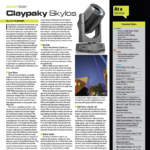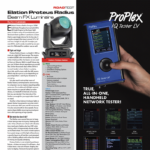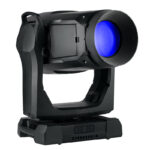What is ColorSource? Electronic Theatre Controls (ETC) has given birth to a family of products that is continually growing. It started with an only child, a Par (wash) fixture, followed by spot fixture. Wireless DMX and relays shortly joined. Now, new to the family, is a series of four consoles: the CS20 and CS40 (reviewed here) and the soon-to-be-released CS20AV and CS40AV. (We’ll probably be kicking the tires of the AV consoles at some point down the road.)
Booting Up
For starters, the front panel of the user interface is sleek and minimalistic. It has a bank of faders on the left, a bank of four faders above the integral touch screen and six command buttons beneath the screen. Push the power button, and the console boots quickly. From the touch screen, enter the patch where Remote Device Management (RDM) compliant fixtures auto populate.
To determine where the fixtures are in the rig, use “identify,” and the RDM fixture will flash on/off. Be sure to use RDM-compliant opto-splitters. Set the addresses, operating modes, and exit the screen. Fixture numbers (ETC calls them “channel numbers”) correspond to the faders. Fixture/Channel 1 is on fader 1. Know that the CS20 can have up to 40 channels and CS40 up to 80 channels. Each channel can be a multi-parameter fixture (like a moving light) or a simple 1-channel dimmer.
Stage Map
The Stage Map, by default, is a mapping with channel boxes arranged sequentially in a grid. As the industry is shifting towards programmers wanting a more visual representation of the rig, ETC didn’t disappoint. The channel boxes can be moved around to an orientation that reflects the plot on stage, or an orientation that makes it easier for you to access the fixtures. The Stage Map is limited in which the icons can’t be changed, however the map can be zoomed in/out. You can select fixtures right from the Stage Map or choose to use the bump buttons or faders. When a fader is raised, it automatically selects the channel.
Programming
Once any number of fixtures are selected, the touch screen guides you and provides the available parameters. For example, select Color, and you are presented with a large palette (ETC calls them “Color Chips”) of colors to choose from. Or, if you need more options, you can press the color mix icon and use the color picker. The Stage Map shows which fixtures are active and displays them in their current color. The bump button under the respective fader does the same.
On screen is a virtual level wheel located on the right. Below is the Clear button, which has options for clearing everything, playbacks, current selection, or channels. Above is the Undo/Redo button which is my favorite. Not sure what just happened or what you pressed? Simply undo it without having the completely clear it and start over.
After finishing the look, press Record on the screen and choose one of the 10 pages of playback/memory faders. Have a theater show and need a cue stack? All CS consoles have one dedicated cue stack with the capability of 999 cues consisting of integers (1,2,3) and point cues up to one decimal place (1.1, 1.2, 1.3).
Playback
Playback on this console can be accomplished a few ways, or a combination thereof. The Cue List is typical for a theater show, while 10 pages of Playbacks are useful for any show. The buttons underneath can serve as a Bump button (flash), Solo, Solo Change, or Move/Go. Also, Tap Tempo enables the bump buttons of playbacks consisting of sequences to set the tempo by repeatedly tapping the button. And we can’t forget about the new feature called Playback Toy. It’s designed specifically for busking on the fly, but making the show looked fully preprogrammed. Above the screen are the four configurable Master Faders which the user can change the functions to: None, Bumps, Cross Fader, Cues and Playbacks. Having master faders only adds to the live playback flexibility and controllability.
Beneath the screen are five configurable buttons (there are actually six buttons, but the first is not editable). They can be customized with the following options: None, Back, Blackout, Color, Cue List, Effects, Go, Independent 1 or 2, Keypad, Pause, Parameter, Playback Toy, Quick Select, Stage Map, or Tap.
Operation Modes
There are two operation modes. First is Simple mode, which has no cue list, no fader pages, and only four playbacks. It’s intended for extremely basic operation, likely for untrained users. (Or a way to make sure the sound guy can’t push the wrong button, or change the fader page, and have to call you in a panic.) The more common mode is the Complete mode with full console operation.
Behind the Scenes
As I was reviewing the CS20 running version 1.0.0, ETC released a software upgrade, version 1.0.2. Upgrading was a simple task, and the manufacturer provided step-by-step written directions to ensure a smooth process for all users.
Multiple show files can be stored in the onboard 2GB of memory. A default show file can be set to load every time the console boots. Furthermore, a “New Show” can begin with default show elements like channel patch already done.
Although ETC continually updates their fixture library, they went a step further and created ColorSource Edit. It is a free program that runs on Windows 7 (or better) and allows users to easily create their own profiles in minutes. Export it to a USB stick, load it into the console and you’re done.
The AV consoles, which are networkable, offer a browser-based network remote called Amigo. It is platform independent, which eliminates the need for an app to download or pay for. Furthermore, since it runs on a web browser, it can run on phones, tablets, and even laptop/desktop computers.
Summing Up
The ColorSource consoles from ETC are designed specifically for the growing channel count of fixtures on the market today. They make a five, six or even seven-color mixing fixture intuitive and simple to use. RDM makes patching a breeze, as it practically does the work for you.
The AV models have yet to be released, but documentation states that a cue can trigger sound clips or video files. ColorSource rid us of a command line and having to learn syntax. Using playbacks, cue stack, live busking, sound-to-light, it can handle small-to-medium sized rigs for all for any type of lighting show — all at an affordable price, backed by ETC’s first class 24/7 support.
At a Glance
Simple and Simpatico
ETC’s new ColorSource consoles make it easier use five, six or even seven-color mixing fixtures. We tried out the consoles in Complete mode, which offers far more functionality than the ultra-basic Simple mode of operation. The control surface starts with one home and five configurable soft key buttons, four configurable function faders, a seven-inch multi-touch touchscreen and RDM discovery and configuration, which makes patching a breeze. Other user-friendly features include an onboard help system with tutorial videos, the Playback Toy for live busking and an effects engine.
ETC CS20 and CS40 Consoles:
- PROS: Simple design, intuitive operation, RDM discovery and configuration, ability to control multi-channel LED fixtures with ease, customizable channel display using Stage Map.
- CONS Some software bugs are still present (V1.0.2 was tested).
CS20 Features
- 1 USB
- 1 DMX output/universe
- 20 faders
- 40 channels of control
CS20 STATS
- Size 18.3” x 10.8” x 2.5”
- Weight 6.9 lbs.
- MSRP $1,749
CS40 Features
- 1 USB
- 1 DMX output/universe
- 40 Faders
- 80 channels of control
CS40 STATS
- Size 26.3” x 10.8” x 2.5”
- Weight 9.55 lbs.
- MSRP $2,690
More Info www.etconnect.com



